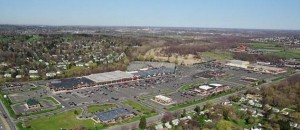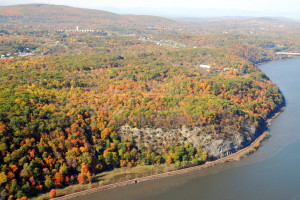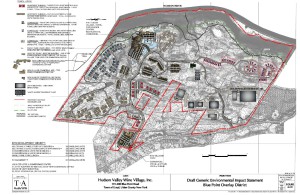“The Towne Center at Fayetteville, NY is designed to replicate the warmth and charm of a traditional American village square.”

(photo: Bergmann Associates. Click to enlarge)
This is the way the developer of the “Towne Center at Fayetteville” (Onondaga County) describes the above project.
As the principles and practices of smart growth appeal to more and more Americans, and as the lexicon of “smart growth”–terms like mixed-use, high density, transit-oriented, new urbanist, walkable, sustainable– gains purchase in the consciousness of the American public, there is demonstrated danger that development will be sold as smart growth when it is really not. By calling the above big-box sprawl mall a “Towne Center” and equating it to a traditional American village, the developer is co-opting the principles of smart growth. In design and location, this project qualifies as sprawl, not as the antidote to it.
We need to beware this not-so-smart growth, recognize it when we see it, and call it out.
A critical case study of this phenomenon is now playing out in the Hudson Valley, where a developer is claiming his project is “consistent with smart growth principles” when in reality it possesses just about all the hallmarks of sprawl.
The Hudson Valley Wine Village is proposed for 429 acres in the Town of Lloyd, in Ulster County across the Hudson River and two miles from the City of Poughkeepsie. Of the acreage, over 80% is forested, and is dotted with wetlands and vernal pools, steep slopes and rock ledges. The property’s most striking feature is its 200-foot bluff overlooking the Hudson.
Here’s an aerial of the site (click to enlarge):

About 16% of the site contains a former winery and vineyards, which have reverted back to old field habitat. Proposed for the site are a whopping 847 residential units, 158,000 square feet of office and commercial space, a 103-room hotel and conference center, retail, and 450,000 square feet of light industrial development.
Below is the preferred site plan. Click on the image to enlarge (you can enlarge it further when the image file opens):

This plan illuminates several classic sprawl characteristics:
The development is too intensive for such a rural and ecologically important site. This site is rural, and is biologically rare and rich enough to be designated a high value biodiversity area. The site is also part of a state-designated scenic corridor. The developer constantly touts that the site will remain “50 to 60% open”. But on the 40 to 50% that will not remain open, there will be 3,000,000 square feet of impervious surface–70 acres of roads, rooftops, and like–as well as 555,000 cubic yards of cut and 466,000 cubic feet of fill. The residential units will be largely townhomes and apartments, housing types rarely fitting for rural areas, and the sprawling single-story industrial sites will carve deeply into these rare remaining woodlands. The forest and open space on the site will be heavily fragmented by widely spread out structures, lots, and roads. Smart growth dictates that the character and ecological integrity of rural areas be preserved, not dramatically altered.
Lacks “location efficiency”. Smart growth requires location efficient siting of development within existing developed areas rather than on “greenfields” on the periphery or in the exurban/rural hinterlands. Location efficient developments also afford options other than the private automobile. Hudson Valley Wine Village is clearly a “greenfield” location.
Empire State Future has encouraged the state to adopt location efficiency screens for its land use, infrastructure, and economic development programs and funding so that development can be steered to the places where the vitality, sustainability, and character of urban, suburban, and rural communities will be improved, not compromised.
Does not utilize existing water infrastructure. The location-inefficient site is not currently served by water or sewer, meaning new infrastructure would be needed. Governments in New York already face a huge funding deficit just to maintain existing water/sewer and road/bridge infrastructure; adding more in a rural area that will need to be maintained forever–and that will enable more rural development–is an indicator of costly sprawl, not smart growth.
Is not really mixed use. The developer claims the project will be mixed use, but in the preferred plan the uses are actually more separated than mixed. For a mix of uses to qualify as smart growth, they would be mixed in the same dense neighborhoods, blocks or even the same structures rather than situated in segregated, spread out pods, and would be close enough together to support easy walking, cycling, and transit use. Without including density as a factor, any collection of uses, no matter how spread out or separated, could be called “mixed use.”
Is not walkable. With its location two miles from existing cores (City of Poughkeepsie to the east and the Hamlet of Highland to the west), and with uses separated and spread, Hudson Valley Wine Village as proposed would not afford easy pedestrianism. With the site laid out and designed primarily for the automobile, pedestrian friendliness would be challenged within the site as well.
Defined by suburban-style street pattern. The street pattern of the Hudson Valley Wine Village lacks connectivity and is punctuated with loop roads, curvilinear streets and cul-de-sacs–typical of auto-dependent, suburban-style design.
Isn’t transit friendly in location or by design. The developer claims adherence with smart growth by saying the development can support transit. But given its location and design, the Hudson Valley Wine Village really cannot be easily transit-oriented; it is two miles from the nearest existing transit lines, and to extend transit to and throughout the site would be a costly and therefore unlikely endeavor.
Empire State Future supports development in the right places, done the right ways, in concert with smart growth principles. We especially oppose development that claims to conform with smart growth when it really does just the opposite. It is incumbent upon smart growth organizations to not only advance smart growth but also defend its integrity against impostors. The Hudson Valley Wine Village would heavily disturb an important natural area and suburbanize a rural community, unnecessary developments when there are much better places and better ways to develop the Town of Lloyd and wider region.




Wow! The analysis rendered regarding The Hudson Valley Wine Village is absolutely correct and right on! Read Suburban Nation, The Demise of the American Dream and you will understand. The proposed design is “classic sprawl.” More than that, it is a travesty and insult to the Hudson Valley.
I can only imagine the types and amounts of IDA relief the corporate developers are after and I hope that they are not permitted or supported in any way toward the realization of their depraved vision for this piece of “God’s Country.” Where are the architects, engineers and corporate/developer “leaders” and who is leading the charge to STOP this atrocity.